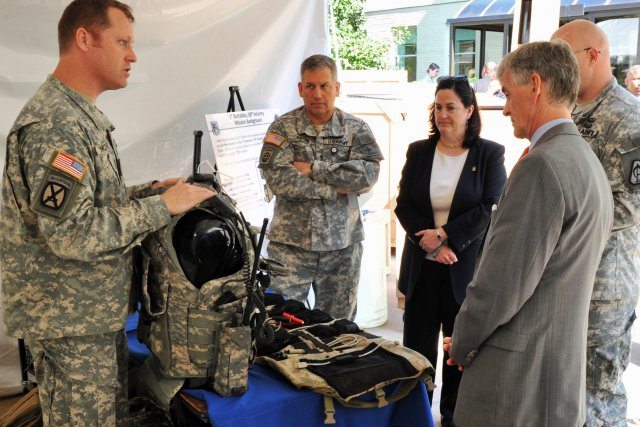Propane and methanol fuel cells, solar-panel collectors and wind turbines are just a few examples of alternative-energy sources on display this week in the Pentagon courtyard.
The demos and exhibits were all part of the Energy and Sustainability Technology Fair to show the ways in which the Department of Defense and can reduce consumption of non-renewable energy sources while increasing efficiency and protecting the environment.
Secretary of the Army John McHugh said the Army was really exercising all the tools in its box without limiting or compromising its capabilities.
“Most critically, we want less exposure for our Soldiers in theater, particularly when every convoy in theater puts Soldiers at risk,” he said. “Seventy percent of our convoy load in theater is fuel and water, so anything we can do to reduce that exposure is a good thing and at the same time we think these alternatives will be huge money savers.
“Anything we can do to decrease our expenditures, that’s good for the Army, good for the taxpayers, and equally important in that we want to be responsible stewards of the environment,” McHugh said.
The Army’s Soldier-worn integrated power equipment system, or SWIPE, was on display from Program Executive Office Soldier — Power. SWIPE has a cable system that provides power that is networked throughout a Soldier’s entire body armor through a conformal battery weighing only 2.2 pounds.
The conformal battery continuously charges all the Soldier’s peripherals for 24 hours then it can be recharged by a foldable solar panel carried in the Soldier’s assault pack. While it’s being recharged, the individual peripheral batteries continue to provide power.
“The battery has cabling that distribute power across the entire ensemble,” said Maj. Mark Owens, PEO-Soldier assistant program manager for power. “It constantly trickle-charges the batteries so the end consequence is Soldiers don’t need to carry extra batteries for all their peripherals.”
Owens said the weight bogey is one of the biggest issues and challenges designers face when trying to increase a Soldier’s capability without continuing to add more and more weight.
“Anytime we talk about implementing new technology, the first thing we look at is, yes, it has to increase the Soldier’s capability, but we have to take something off of him — preferably taking more off than what we’re adding,” he said. The conformal battery has been used by the 2nd Stryker Cavalry regiment and the 3rd Brigade, 25th Infantry Division Stryker Brigade Combat Team during their deployments.
A solar-powered portable water purification systems for Soldiers in remote areas will be headed to Fort Roberts, Calif., for testing next month. The Solar Hybrid Expeditionary Purification System, known as the SHEPS footlocker system, will undergo capabilities-based experimentation or CBE by the Special Operations Command, according to Worldwater and Solar Technologies vice president for project management, Melissa G. Burns.
SHEPS consists of two 80-pound footlocker-sized boxes, one of which contains batteries that power a water-purification system which is in the other box. Connected to the battery bank are four 135-watt folding solar panels that can either drive the water system directly or continuously charge the batteries.
The water-purification system can produce 100 gallons per day straight from solar and about 250 gallons per day when powered by the battery system. Burns said SHEPS can also use power from external sources to produce upwards of 450 gallons freshwater per day from tainted freshwater, brackish water or seawater sources.
“Our systems can really work anywhere a traditional infrastructure is compromised, non-existent or unreliable, so that would certainly span expeditionary forces as well as Department of Defense forward operating bases,” she said, adding that the SHEPS can be used for disaster relief as well as in international development.
The company also builds a Prepositioned Expeditionary Assistance Kit, or PEAK, which provides water-purification, renewable power, backup generator, situational awareness and communications in what Burns called an “easy-to-use, self-contained, self-powered ISU 60 shipping container that can be helicoptered, trucked or boated anywhere.” PEAK is presently undergoing operational testing with Joint Task Force Bravo in Honduras.










